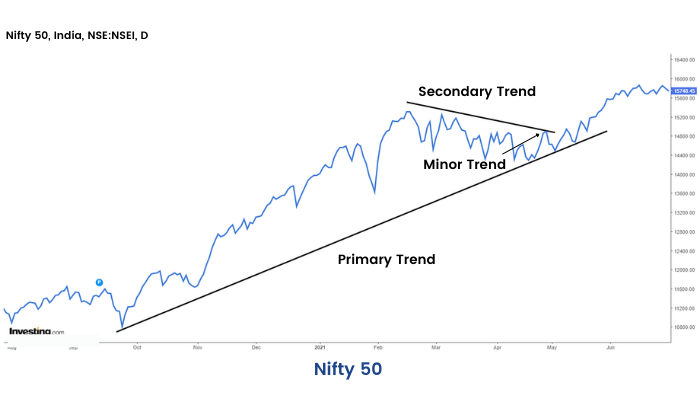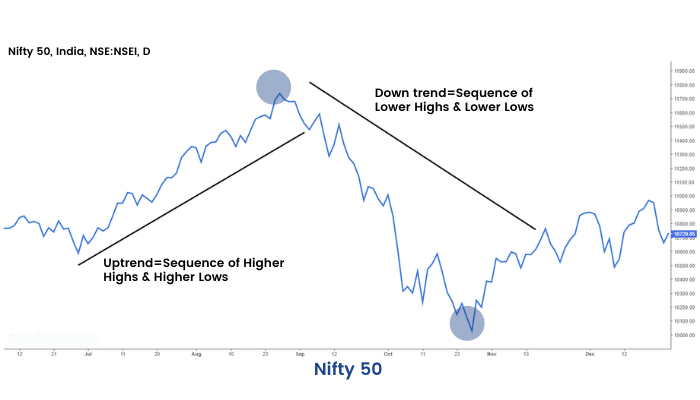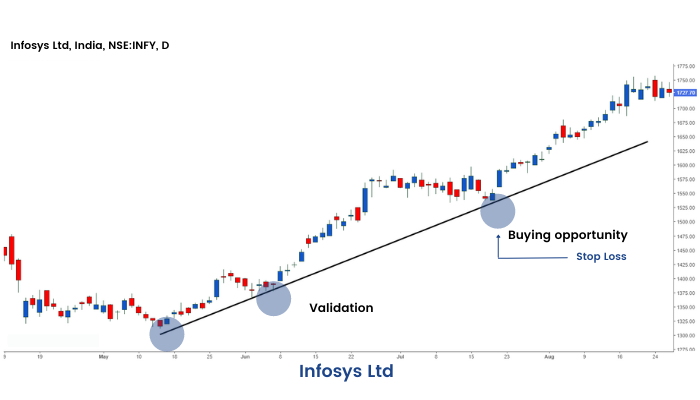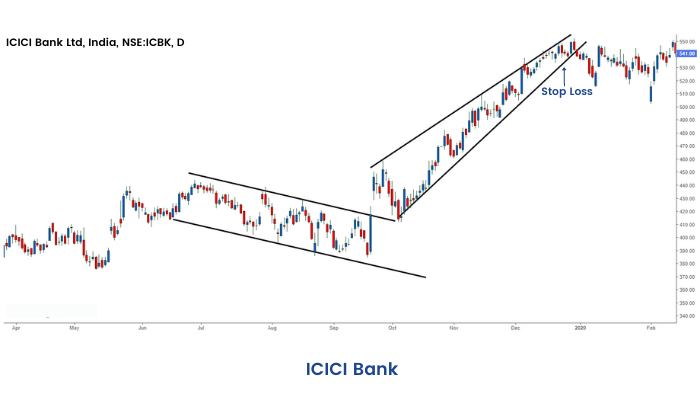Trends
Stock prices always move in trends. After learning the different types of technical charts, in this section, we will discuss the different types of market trends.
Market Trend and Range-Bound Consolidation
Often market movements happen in the form of trends. A price trend is a continuous or a directional price movement in upward or downward direction. We call them uptrend and downtrend respectively. Now if we look at price action in the market through charts, we will find that no price movement happens in a straight line.
Suppose we are looking at a broader uptrend represented as primary move, we may find intermediate corrections represented as a secondary trend and minor counter moves among the secondary moves represented as minor trend. This is how the market behaves generally in both the up and the downtrends.
Here is an example of Market Trends:

Often an uptrend is represented in the form of a sequence of higher highs and higher lows. Similarly, a downtrend is represented as a sequence of lower lows and lower highs. A trend is said to reverse when the sequence is broken.
Here is an example of Trend Reversal:

We should remember a simple point that the market is not trending all the time. Often the market consolidates within a small range and goes nowhere. Then suddenly it can break on the upside or downside.
Here is an example of Market Consolidation:

Trendline & Channels
Trendline and Channels are one of the most simple and useful tools in the market. During an uptrend, a trendline is formed by joining the lowest points of periodic pull-backs, defined as secondary moves in the previous section. The up-trend line has a positive slope. To be precise we need two lows to join to form a trendline during an up-move. This line is then extended in the upward direction; the third move towards the trend-line is used to validate the trend line. If the trend line is not broken in the pullback, then it is called trend-line validation. It is often observed that price pulls back towards the trend line and moves higher. In an up-trending market, it is often easier to make money if one buys near the trend line and sells higher. The more number of time the trend-line is validated, the more important it becomes. An upward trend line is said to be the area of support. The selling pressure meets the buying pressure here and eventually, overtime when buying pressure is higher than selling pressure price sees an upward bounce.
Here is an example of an Uptrend:

Now when one buys he or she is looking for the prices to move higher. But this may or may not happen. Hence the investor should maintain a stop-loss point below which he or she should cut his or her position, i.e. book loss.
When a trend line is broken, either the market may reverse the trend, continue the uptrend with little less force or just go sideways.
Here is an example of Uptrend Reversal:

Similarly, during a down-trend: a trendline is formed by joining pull-back highs. They slope downwards. Just like an up-trend line a down-trend line is formed by joining two points and then extended in a downward direction. Pullbacks towards the trend-lines are low-risk points for short selling with a stop loss little above the trend line. The more times the line is validated, the more it grows in importance.
Here is an example of Downtrend:

Similar to an uptrend-line, when a down-trending line is broken the trend may continue with less pace, or reverse or may go side-ways. A downward trend line is said to be the area of resistance. The selling pressure meets the buying pressure here and eventually, over time, when selling pressure is higher than buying pressure price, sees a decline.
Role Reversal
Once a trendline support or resistance is broken, its role is reversed. If the price falls below a support line, that line will become resistant. If the price rises above a resistance line, it will often become support. As the price moves past a line of support or resistance, it is considered that supply and demand have shifted, causing the breached line to reverse its role. For a true reversal to occur, however, it is important that the prices make a strong move through either the support or resistance line.

Channels
The concept of a channel is much similar to trend lines. When in an uptrend or in a downtrend or in consolidation, we see rhythmic movement in the form of a parallelogram, we can draw channels. The channel boundaries are good points for reversal trades with small stop losses.
Here is an example of Channels:

Once the price is out of the channel, the trend or range of the stock is broken.


